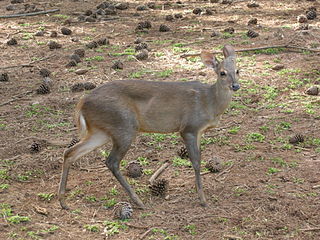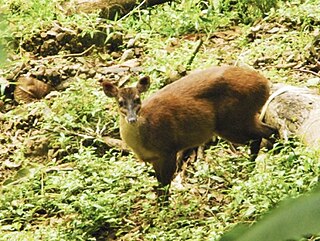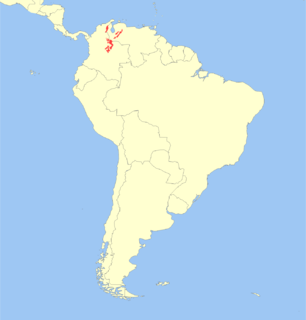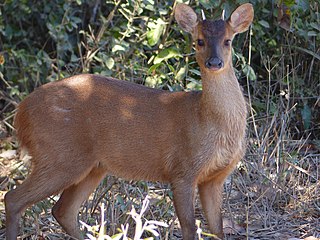 W
WThe Amazonian brown brocket, also known as the small brown brocket, is a small species of deer that is almost entirely restricted to South America.
 W
WBrockets or brocket deer are the species of deer in the genus Mazama. They are medium to small in size, and are found in the Yucatán Peninsula, Central and South America, and the island of Trinidad. Most species are primarily found in forests. They are superficially similar to the African duikers and the Asian muntjacs, but unrelated. About 10 species of brocket deer are described.
 W
WThe Central American red brocket is a species of brocket deer ranging from southern Mexico, through Central America, to northwestern Colombia. In 1792 Robert Kerr originally described it as a unique separate species as opposed to a subspecies. It was treated as a subspecies of the red brocket from South America, but its karyotype has 2n = 50, while the latter's was initially described as having 2n = 68–70. However, a more recent description gives the red brocket a variable karyotype with 2n ranging from 48 to 54, suggesting it represents several species. It is sympatric with the Yucatan brown brocket over part of its range. Additionally, it was estimated that Mazama temama diverged from other red brocket deer about 2 MYA. This was estimated through analysis of concatenated sequences from the mitochondrial gene ND2, Cytb, and tRNA-Pro-Control region. The species is found in primary and secondary tropical forest at altitudes from sea level to 2800 m. In Mexico, it is regarded as an agricultural pest by bean farmers. It is probably threatened by hunting and deforestation.
 W
WThe dwarf brocket, or chunyi, is a small species of deer native to the Andean highlands in western Bolivia and southeastern Peru, where it is found in forest and páramo. Its pelage is reddish-brown with dark grey foreparts and neck. The underparts are lighter brown, and the muzzle short and thick. It weighs around 11 kg.
 W
WThe gray brocket, also known as the brown brocket, is a species of brocket deer from northern Argentina, Bolivia, southern Peru, eastern and southern Brazil, Paraguay, and Uruguay. It formerly included the Amazonian brown brocket and sometimes also the Yucatan brown brocket as subspecies. Unlike other species of brocket deer in its range, the gray brocket has a gray-brown fur without reddish tones.
 W
WThe little red brocket or swamp brocket, also known as the Ecuador red brocket, is a small, little-studied deer native to the Andes of Colombia, Ecuador and northern Peru, where found in forest and páramo at altitudes between 1,400 and 3,600 metres. It is one of the smallest brocket deer. The coat is reddish, and the legs and crown are blackish. As recently as 1999, some authorities included both the pygmy brocket and Merida brocket as subspecies of the little red brocket.
 W
WThe Mérida brocket, also known as the Meroia brocket or rufous brocket, is a small species of deer. It is found in forest and páramo at altitudes of 1,000–3,500 metres (3,300–11,500 ft) in the Andes of northern Colombia and western Venezuela. It was once treated as a subspecies of the similar little red brocket, but has been considered a distinct species since 1987, though as recent as 1999 some maintained it as a subspecies.
 W
WThe pygmy brocket is a brocket deer species from South America. It is found in southern Brazil, Argentina and Paraguay. It is a small deer with short legs, weighing 15 to 20 kilograms. It is reddish-brown in color.
 W
WThe red brocket is a species of brocket deer from forests in South America, ranging from northern Argentina to Colombia and the Guianas. It also occurs on the Caribbean island of Trinidad.
 W
WThe small red brocket is a small species of deer in the family Cervidae. It is endemic to Atlantic Forest in Paraná, Santa Catarina and São Paulo in southeastern Brazil. This species, which only was scientifically described in 1996, is threatened by habitat loss. Though its size and structure most resemble that of the pygmy brocket, its coloration is very similar to that of the red brocket. It resembles hybrids between these two species even more closely, but differs from both, and their hybrids, in karyotype.